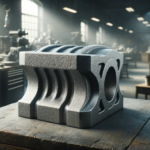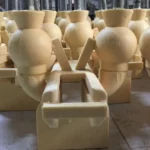Language:
Design Your Ideal Investment Casting Projects with Our Expertise
We possess casting technology that surpasses most other foundries in China, backed by over 40 years of casting experience. Our expertise enables us to cast intricate components, having worked with nearly 20 different metal alloys. Situated within the coal and steel industry belt of China, we enjoy a substantial energy cost advantage, allowing us to provide you with quotes that exceed your expectations.
How To Get Started

Getting a Quote
To receive a prompt quotation, kindly upload your drawings or 3D files and provide us with your specifications.

Placing Your Order
Upon confirming your order, production will commence promptly, and you will receive regular updates on the progress.

Receiving Your Order
We offer comprehensive quality assurance, reports, as well as tracking and delivery updates for your convenience.
Our Manufacturing Process
#1. Design and Engineering Expertise
Please provide us with engineered drawings and specifications for the components you require, including (though not confined to) all dimensions, stress/load criteria, machining particulars, and NDT prerequisites.
#2. Precision Mould Design and Development
The process of Mould Design and Development is tailored to match product specifications and the required quantities.
#3. Efficient Production Workflow
We oversee the entire manufacturing process.
#4. Precise Machining and Finishing
Additional processing may include machining, coating, or assembly, as necessary.
#5. Rigorous Quality Control Measures
We manufacture precisely in accordance with your drawing specifications and have the capability to rigorously adhere to drawing standards. We conduct the required product testing with strict compliance, ensuring adherence to all product specifications.
#6. Secure and Efficient Packaging
We prepare and package all products to safeguard them during transportation and storage.
Request a Quote
Specifying and Ordering Customised Metal Castings: A Guide
10 Key Factors for Achieving Successful Customised Metal Casting Projects.
When requesting metal casting pricing from a supplier foundry, it’s essential to address at least 10 important considerations:
- Initial Casting Design
- Quantity Requirements
- Detailed Specifications
- Casting Soundness
- Testing and Inspection Procedures
- Weight Specification
- Patterns Development
- Machining Services
- Production and delivery schedules
- Ordering Castings
1. Initial casting design
Designing a cast metal part should consider leveraging the casting process to its fullest potential. To ensure efficient and cost-effective production, casting design should opt for the simplest production methods that meet the desired physical properties, net shape requirements, and cosmetic appearance.
Requests for quotes should include detailed drawings specifying the exact dimensions of the required part.
There are several crucial aspects of design where familiarity with foundry processes or effective communication with supplier foundries can aid in identifying the most cost-effective designs from the foundry’s perspective.
Minimum section thickness
Each casting must adhere to minimum thickness requirements determined by its strength and rigidity. Designs that deviate from these specifications may render the project uncastable. Successful casting designs must enable the molten metal to flow into the thinner sections.
Molten metal cools rapidly, potentially preventing it from reaching distant thin sections, particularly those far from the mold’s gate. Generally, designs should avoid areas thinner than 0.25 inches (6 mm) when employing conventional processes. Investment casting offers greater flexibility, allowing wall thicknesses to be reduced to as little as 0.030 inches (0.76 mm).
Draft and core
The term ‘draft’ pertains to the taper on the vertical surfaces of a pattern. Draft angles are essential to facilitate the removal of the pattern from the mould without damaging the mould walls. Neglecting these angle constraints can result in mould tearing during removal from the casting.
Several factors influence the required draft angle for each casting: the manufacturing process, casting size, and whether the moulding is manual or automated will all influence the necessary degree of draft. Machine-moulded castings generally require less draft, while castings produced with green sand moulds typically demand more than usual. A general rule of thumb is to allow for 3/16 inch of draft per foot (approximately 1.5 degrees).
Cores are hollow spaces formed within a casting using moulding sand. Cores become necessary when patterns alone cannot create the required spaces or cavities. Although the use of cores can eliminate the need for draft, their utilisation should be limited, as they contribute to the casting’s overall cost.
Three factors determine the minimum diameter of a core that can be placed within a casting:
- The thickness or depth of the area where the core will be situated.
- The length of the core.
- The casting method employed by the supplier foundry.
Parting line
Establishing a single-plane parting line streamlines both pattern and mould production. Patterns featuring straight parting lines, aligned in a single plane, can be manufactured more efficiently and cost-effectively than those with irregular parting lines. Casting shapes that possess symmetry naturally suggest the location of the parting line. Embracing such symmetry in casting design simplifies both moulding and coring processes and should be adopted whenever feasible. These designs should always be fashioned as ‘split patterns’ (consisting of separate cope and drag components). Split patterns demand minimal manual intervention during mould creation, enhance casting surface quality, and contribute to cost reduction.
Cores
A core is a distinct component, often crafted from moulding sand, inserted into the mould to create apertures and voids that cannot be formed by the pattern alone. In the pursuit of cost reduction, every effort should be made during the design phase to eliminate or minimise the necessity for cores.
The minimum core diameter suitable for use in steel castings depends on three key factors:
- The thickness of the metal section surrounding the core.
- The length of the core.
- The specific precautions and procedures employed by the supplier foundry.
As the metal thickness encompassing the core increases and the core diameter decreases, the challenging thermal conditions to which the core is exposed become more severe. These conditions necessitate effective dissipation of the escalating heat emanating from the bulky section through the core. The greater severity of thermal conditions makes the cleaning and removal of castings and cores significantly more challenging and costly.
Both the thickness of the metal section surrounding the core and the length of the core influence the bending stresses induced in the core by buoyancy forces. This, in turn, impacts the supplier foundry’s ability to achieve the required tolerances. In cases where the core size is sufficiently large, reinforcement rods can often be employed to enhance core strength. Naturally, as both the metal thickness and core length increase, the demand for additional reinforcement to withstand bending stresses also grows. Consequently, the minimum core diameter must expand to accommodate the supplementary reinforcement.
When areas within the casting are inaccessible, the cost of removing cores from the cavities can become prohibitively expensive. Casting designs should incorporate adequately sized openings to facilitate core removal.
Inaccessible areas within the casting pose challenges for core removal, potentially affecting the economic viability of projects. Hence, castings should invariably be designed with openings of sufficient dimensions to allow for core removal.
Typically, castings are dispatched with unmachined, as-cast surfaces, unless alternative specifications are provided. To optimise the casting process, the supplier foundry should be informed of the surfaces intended for subsequent machining (refer to ‘8. Machining Services’ below for further details) and the locations of datum points. Additionally, the acceptable dimensional tolerances must be stipulated when providing a drawing. Normally, the agreed tolerances are determined through collaboration between the supplier foundry and the customer.
Effective collaboration between the customer’s design engineers and the supplier foundry is paramount for the optimisation of casting design. To ascertain the feasibility of the casting project, all casting designs should undergo scrutiny by a foundry professional before production commences.
2. Quantity Requirements
The quantity of castings required or the production run length should be clearly specified. The order quantity significantly influences the price, with longer production runs generally resulting in a lower cost per casting.
The quantity of parts needed is a critical consideration. It not only dictates the type of tooling required but also determines a foundry’s capacity to meet production volume requirements.
Certain foundries specialise in short-term, short-run “jobbing” work, while others focus on high-volume production. Clearly defining your requirements early on ensures you engage with the appropriate production facilities.
3. Detailed Specifications
Industry-standard specifications provide the tools for establishing criteria for nearly any casting application. These specifications do not exclude special requirements that the customer’s technical staff may necessitate. Deviations from standard specifications can lead to misunderstandings, increased costs, and potential disqualification of supplier foundries. If an exception is made to a provision in the primary body of a specification requirement (as opposed to a supplemental requirement), the resulting casting may not comply with those specifications.
Mechanical properties can be verified using test bars, either cast separately or attached to the castings. These mechanical properties reflect the quality of the metal but may not necessarily represent the properties of the castings themselves, which are influenced by solidification conditions and the rate of cooling during heat treatment. Factors such as casting thickness, size, and shape also affect this. The hardening ability of some grades may limit the maximum size at which the required mechanical properties can be achieved.
Heat treatment
Heat treatment is employed to standardise, homogenise, and enhance the properties of specific alloys. For many alloys, it is a routine process to ensure that the specified minimum physical properties are achieved in the final cast products. Modern heat treatment furnaces are equipped with temperature-controlling devices and advanced temperature recording equipment to ensure consistency and high quality heat treatment.
In certain cases, specialised heat treatments like flame hardening or case hardening may be specified as additional processes conducted by the supplier foundry.
4. Casting Soundness
Soundness in metal components refers to the level of freedom from impurities and discontinuities, such as sand inclusions, slag inclusions, macroporosity, and shrinkage. Achieving a completely defect-free casting is impossible; variations in defect levels are expected. The acceptance or rejection of castings is determined by examining parts based on internationally recognised standards, such as ASTM, according to customers’ formal engineering requirements; acceptance and rejection criteria are agreed upon by the supplier foundry and the client before production, impacting both casting costs and production processes.
5. Testing and inspection Procedures
Post-production, all castings must undergo testing to ensure they meet specification requirements. Castings are also subjected to dimensional accuracy, surface finish condition, physical properties, internal soundness, and crack inspections. In many applications, testing is mandatory, and additional tests may be necessary to meet material specifications or other general requirements.
Testing and acceptance criteria must be communicated and agreed upon before production. Stricter testing terms increase the overall cost, so testing and acceptance conditions should be aligned with the precise requirements of each application.
Destructive testing
Destructive testing necessitates an additional test casting alongside the required part. The test casting is destructively examined to assess internal soundness, such as the volume of inclusions, shrinkage, or gas presence. Destructive testing tells only the tested piece’s condition and doesn’t guarantee the soundness of non-tested pieces. Nonetheless, it’s widely employed in practice. If the test casting meets the criteria, production can proceed with the assumption that castings produced similarly will exhibit the same level of soundness.
Non-destructive testing
Non-destructive testing methods are used on the casting itself to assess internal and external soundness without damaging the product. These methods include visual inspection, dimensional inspection, liquid dye penetrant inspection (LPI), magnetic particle inspection (MPI), ultrasonic testing (UT), and radiographic inspection (X-Ray).
Following inspections, inspected and accepted castings may be used as-is and shipped to clients, but often they undergo further processing. This can include specialised heat treatment, painting, rust preventive coatings, other surface treatments (like hot-dip galvanising), and machining.
6. Weight Specification
Material represents a significant cost component in any casting. The greater the casting’s weight, the higher the material cost will be. Providing detailed weight information about the parts in question enables foundries to make more accurate price calculations.
Foundries are primarily concerned with the gross weight of the casting, which measures the weight of molten metal required to fill a mould, including the resulting casting and all feed material (gates, risers, etc.) needed to ensure a sound casting results from the casting process. A foundry’s casting price will be significantly affected by the casting yield (the efficiency of the casting process and the weight of the resulting casting divided by the weight of the feed metal poured into the mould) they achieve.
7. Patterns Development
Pattern equipment design and associated costs can lead to significant misunderstandings between customers and supplier foundries. Decisions such as the construction of new pattern equipment, even when existing equipment is available, the choice between a full split core box and a half core box, opting for metal patterns instead of wooden ones, or preferring mounted patterns over loose patterns can impact equipment costs. Typically, more sophisticated pattern equipment, while generating higher pattern costs, results in lower casting costs and superior casting quality.
8. Machining Services
Machining, the mechanical removal of excess material, is vital for achieving high dimensional accuracy. Adequate machining allowance should be allocated when needed, especially for parts requiring tight tolerances.
Tolerance, which reflects the achievable dimensional accuracy for a given production method, is influenced by mould expansion, solidification shrinkage, and thermal contraction in the green sand casting process. Therefore, there are tolerance limits for as-cast parts. Subsequent machining is commonly employed to achieve tighter tolerances.
Not all supplier foundries offer in-house machining, but they are responsible for producing a cast product that can be machined to meet its specific requirements. Close coordination is necessary between the customer’s engineering and purchasing teams and the casting producer. Key considerations include the casting process, machining stock allowance, product design, material specification, and heat treatment, as well as the quantity of parts to be produced. Casting designs should be thoroughly reviewed to ensure that all machining requirements are achievable.
9. Production and delivery schedules
Effective communication of delivery and demand requirements is crucial to finding the right shop to meet both short-term and long-term needs.
In addition to the considerations mentioned above, it’s imperative for both customers and suppliers to be aware of production schedule needs. Timelines should be communicated well in advance of the required delivery date. Due to the complexity of the metal casting process, project lead times can extend up to 24 weeks, including commercial considerations, pattern and tooling construction, sampling, inspections, pattern changes, full production setup, production, post-production processes, and more.
10. Ordering castings
The successful outsourcing of a metal casting project requires close cooperation between the supplier foundry and the customer. The supplier foundry should be involved from the early design stages through to manufacturing and product delivery.
Upon receiving a quote request, the supplier foundry collaborates with clients to evaluate all costs and establish product objectives. Careful planning benefits both the foundry and the customer, as the foundry’s experts assess the project before production and recommend the best materials and methods for an economical solution.
By providing foundries with detailed and accurate information about their casting requirements, customers can expect to receive ample feedback, inquiries, and pricing from interested parties. Thorough preparation streamlines the ordering process, saves time, and reduces the likelihood of errors in the final product.
Credentials Beyond Compare


We are a professional investment casting foundry with a long-standing ISO 9001 certification, which reflects our ongoing dedication to maintaining high-quality management practices and our consistent delivery of top-notch products and services while meeting customer regulatory requirements. Additionally, we have received certification from TUV, affirming our commitment to upholding stringent quality standards and our continued pursuit of excellence.
Trending now



